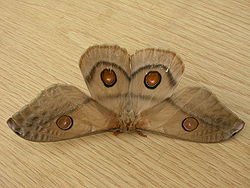
- Kingdom: Animalia
- Phylum: Arthropoda
- Class: Insecta
- Order: Lepidoptera
- Family: Saturniidae
- Genus: Opodiphthera
- Species: O. eucalypti
Opodiphthera eucalypti
| Emperor gum moth |
|---|
 |
| Scientific Classification |
|
| Binomial Name |
Opodiphthera eucalypti |
The emperor gum moth is a species of moth known by the scientific name Opodiphthera eucalypti. It can live up to 10 years in its cocoon if the environment is not right for it to come out.
A moth is an insect closely related to the butterfly. Both are of the order Lepidoptera. Moths have thick feather like antenna while butterflies have thin filamentous antenna. Moths are mostly nocturnal (only are awake during the night) while butterflies are mostly diurnal (only awake during the daytime).
The Emperor Gum Moth eggs are very small tan ovals and are about 2mm in length. Newly hatched caterpillars are black. As they grow they develop yellow and white markings with short hairs on raised tube structures named tubercles that stand off the body (this is the first and second stage of development).During the third and fourth stages of development the caterpillar has turned a bright green color and its tubercles have turned a stunning bright red. At the fifth and the final stage before pupation, the caterpillar turns a blue-green color and has a tan stripe down its side. [1]
The adult Emperor Gum Moth is a large moth with a wingspan of 120-150 mm. Females are usually larger than males.have furry wings and body, and range in color from pale reddish-tan to deep pinky-brown with four distinct "eye spots" - one on each wing.Eye spots on the front wings are circled in dark reddish-brown with a tan center and a white dot in the middle. The eye spots on the back wings are bigger than those on the front wings and are circled in black with blue and orange centers and a white dot in the middle. The male moth's antennae are usually large and feather like in appearance while the females are usually plain and normal. [2]
The Emperor Gum moth goes through 5 stages of development.through the five stages during they change enormously in size and color. the egg of the moth is first laid on either the top or the bottom of the leaf, which side does not matter. the are laid in groups of 3 or 2 or are just laid one at a time. They hatch after seven to ten days and the caterpillars begin to feed.The caterpillar does not move much it stays close to where it hatched and does not move much. The caterpillar stage may last for many weeks, depending on temperature of their home. the caterpillar then makes itself a thick silk cocoon where There is usually only one generation per year. Most moths emerge from their cocoons in the year following pupation but some may remain in the cocoon for two to five years. [3]
The emperor gum moth lives in native Australia, it feeds on a wide range of Eucalyptus and also on many introduced species such as peppercorn trees, silver birches(Betula sp), Liquidambars and apricot trees. The late caterpillar stages have also been recorded as feeding on Pinus radiata. The eggs of the emperor gum moth are usually laid on the under side of the leaf. The adults usually do not eat but when they do they usually only eat at night. [4]
The emperor gum moth has been implicated in carrying a virus that was transferred to crickets. The virus supposedly give the crickets and other insects paralysis. Three virus-like particles have been isolated from diseased larvae of Antheraea eucalypti. Serological tests established that one of them was very similar, some might even say indistinguishable from cricket paralysis virus. CrPV isolated from crickets and from Antheraea were cross-infectious. Crickets could get the virus by feeding on infected Antheraea larvae. Three other species of Orthoptera and nine moths tested were in danger of catching the virus. It is suspected that the field cricket has acquired it by a food chain from the moths.[5]
|
||||||||||||||||||||